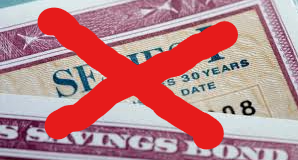
Is It Time to Redeem Your Series I Savings Bonds?
By John H. Robinson, Financial Planner (February 22, 2024)
To be as unambiguous as possible, my advice to consumers who purchased I- bonds in the six-month period from May to October 2022 when the inflation-linked rate was 9.62%, should redeem their bonds NOW. That is because the fixed rate component on those bonds is permanently set at 0% and the current inflation competent is just 3.38%. This is not competitive relative to comparably secure investments such as treasury bills and CDs.
In redeeming the bonds, consumers should be aware that there is a 3-month interest penalty on bonds redeemed within five years of purchase. The 3.38% rate has been in place since October 1, 2023, so the current redemption penalty will be less than 1%.
I am far from alone in making this recommendation. Here are links to articles from the mainstream financial news media that echo this sentiment:
Is it a good time to cash in your I-bonds? (Kiplinger)
How to maximize Series I bond redemptions amid falling inflation (CNBC)
What if I purchased my I-bonds after October 2022?
Consumers who purchased I-bonds between November 2022 and April 2023 receive not only the inflation (CPI) index interest rate, but also a .4% boost from a fixed rate that is locked in for the life of the bond. For consumers who purchased between May and October 2023, the fixed rate is .9%. Consumers who purchased during the current 6-month period between November 2023 and April 2024, will receive a 1.3% fixed rate on top of the CPI-linked component.
The current effective 12-month composite yield is a seemingly respectable 5.27% (state-tax-free). With the consideration of the lifetime fixed component, many/most financial advisors are encouraging consumers to stand pat for at least a full five years. This is where my advice departs from the herd.
I am recommending that all consumers who purchased I-bonds from November 2021 through November 2022 redeem their bonds now and that all consumers who purchased from December 2022 redeem their bonds after 1 year and 3 full months after the date of purchase regardless of the fixed rate component.
The Treasury Direct Website is Dysfunctional
The rationale behind my recommendation has little to do with the outlook for interest rates and/or inflation. I do not disagree that the current 5.27% annualized rate on new I-bond purchases is still competitive. Instead, my recommendation to redeem is based on the fact that the entire platform for purchasing and redeeming savings bonds is dysfunctional.
To illustrate this by example, I purchased a $10,000 I-bond for my son Brody in May 2022 when he was 17. Since Brody was a minor, I purchased the I-bonds in his name and social security number with me as his custodian. When I logged into Treasury Direct to try to redeem the bonds last September (1 year + 3 full months after purchase), the Treasury Direct system would not process my redemption request because he is now legally an adult.
We followed the instructions for transferring the bonds to his name and his own Treasury Direct account, but it did not work. We also discovered that there is no functioning chat support and email support has been discontinued. That leaves only phone support, where hold times frequently exceed two hours, or you receive a message that phone support has been overwhelmed with calls and cannot accept any more calls for the day.
The only article I could find that touches on this problem is the following post from early 2022 which touched on staffing issues at Treasury Direct creating problems for new purchasers.
U.S. Savings Bond Program Plagued by Understaffing as Demand Soars (Federal Times)
While similarly disastrous purchase and redemption experiences have been reported to me by FPH clients and are supported by scores of consistently dismal consumer reviews on sites such as Yelp and Reddit, Treasury Direct’s abysmal website and support remain largely overlooked and unreported by the mainstream media.
Your Savings Bonds May Never Be Redeemed!
Another BIG problem with savings bonds that has gone entirely overlooked in the financial news is the fact that Treasury Direct (TD) does not provide any reporting to Savings Bond holders from purchase until the time the bonds are redeemed. Because the interest accrues tax-deferred, there are no 1099’s issued, and TD does not deliver any annual or quarterly valuations or statements of any kind.
According to the Treasury’s Bureau of the Public Debt, there are $26 billion in Savings Bonds that have reached final maturity and have not been redeemed. In many cases, the owners of these bonds have passed away, and the beneficiaries (if they were named at all) have no idea that the bonds are waiting to be claimed.
To Me, I-Bonds Are Not Worth the Hassle or the Risk
The historic high interest rates offered on I-bonds issued in 2021 and 2022, were arguably worth the hassle for some consumers. In retrospect, the time and effort it took for me to establish and redeem the bonds for the six members of my family, was not worth it. I would not purchase I-bonds again, even if inflation spikes.
My recommendation that consumers who recently purchased I bonds redeem them may be controversial, but even those who disagree should at least be aware of the exogenous considerations cited in this article. It is worth mentioning that I even recommend redeeming bonds purchased more than a decade ago since the fixed component of the I-bond rate calculation has ranged from 0%-.5% since as far back as 2008. It is, however, always a good idea to take into consideration the total amount of accrued interest and its potential impact your income tax before redeeming.

